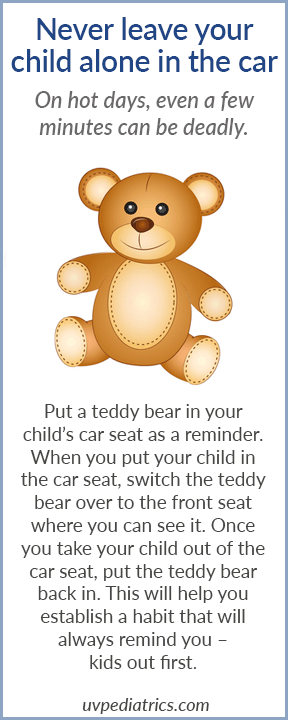Article at a Glance
- Children under six months of age should avoid sun exposure to prevent sunburn.
- Covering up is the best line of defense against exposure to ultraviolet radiation.
- High-intensity activities lasting more than 15 minutes should be reduced when heat and humidity reach critical levels.
Fun in the sun

When the weather is warm, and even when it isn’t, we must remember the importance of protecting ourselves and our children from the harmful effects of the sun. Before taking your family out to Strawberry Days or the Provo Farmer’s Market this summer, remember that dangerous health problems ranging from sunburns to heatstroke can be avoided with a little planning and diligence.
Infants under 6 months
The American Academy of Pediatrics (AAP) recommends that infants avoid sun exposure to prevent sunburn. Dress your children in lightweight long pants, long-sleeved shirts, and full brimmed hats that completely shade the face and neck. When you must take infant children into the sun, apply a minimal amount of sunscreen with at least 15 SPF to exposed areas like the face, neck, and the back of hands.
All other children
- Covering up is the best line of defense against exposure to ultraviolet radiation. Stay in the shade when possible, and limit exposure between 10 a.m. and 4 p.m. when the UV index is at peak intensity.
- Wear sunglasses rated for at least 97% UVA and UVB protection, a hat with at least a three-inch brim or forward-facing bill, and tightly weaved clothing.
- Apply sunscreen to exposed areas every two hours, and again after swimming or sweating.
- Use extra caution near water, sand, and snow as they all reflect UV rays and can drastically reduce the amount of time it takes to get a sunburn.
Exercising and heat stress
- High-intensity activities lasting more than 15 minutes should be reduced when heat and humidity reach critical levels.
- At the start of an intense exercise program or after traveling to a warmer climate, gradually increase exercise intensity and duration over a period of 7 to 14 days to acclimate the body to extreme heat and humidity.
- Children should drink freely before physical activity and should not feel thirsty. Children should always have access to water or a sports drink and take a hydration break every twenty minutes while active in the heat. Water alone is fine when activities last less than one hour.
- Lightweight, light-colored clothing should be limited to one layer of absorbent material to encourage evaporation of sweat. Children should change into dry clothes if theirs become saturated with sweat.
- Games and practices should include plenty of hydration breaks and be shortened in duration when heat or humidity levels reach extremes. Children who feel dizzy, lightheaded, or nauseous should be immediately moved to cooler environments.
Heatstroke
The small bodies of infants and children cannot regulate body temperatures in the same way grownups do. Children die every year from heatstroke as the result of being left in a hot car, the majority of which are under three years old.

Share this article:
